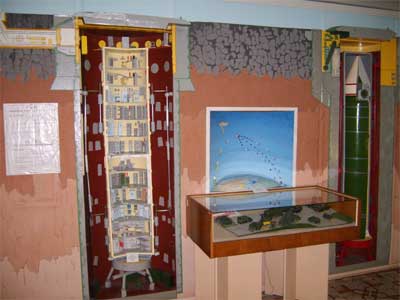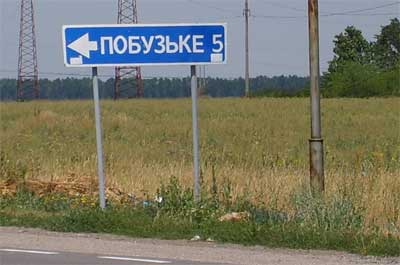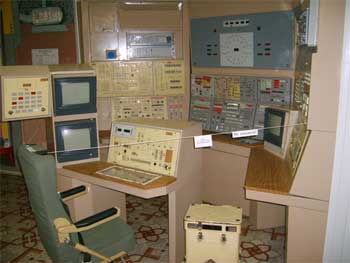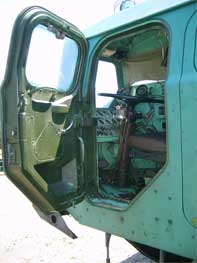Ukraine: Museum of Strategic Missile Troopsnear Pobuzke (Побузьке), 30 Km north of Pervomaysk (Первомайськ), Ukraine.During the Cold War, 176 nuclear missile launching silos were located at missile bases across Ukraine. Following the collapse of the Soviet Union, under the 'Strategic Arms Reduction Treaty' (START) agreement with the USA, they were all demolished ... all except one ... That one remaining complex was turned into the 'Museum of Strategic Missile Troops' (aka the 'Nuclear Missile Museum') which Lonely Planet Ukraine considers "arguably Ukraine's coolest museum". Unfortunately, as Lonely Planet mentions, it's not the easiest museum to reach independently (apparently Soviet military bases weren't located near major public transport hubs). If you have heard about it, and want to know more, I hope this page will be helpful. The MuseumThe museum was founded on 20th October, 2001, and is open every day from 10am to 5pm.
(Hilary & I visited on 14th July, 2008 and paid 20 uah for the two of us) The museum is maintained by ex-missile troops officers, who double up as tour guides (but none speak English). The museum comprises the Command Post, and one of the ten missile silos that the base used to control, complete with surface buildings and underground connecting tunnels.
Once through the main gates you wait for your guide. On the way to the first building is a decommissioned P-12 'Sandal' missile of the type that used to be stationed here, with its guts extracted and mounted on plinths either side of the path.  Museum of Strategic Missile Troops entrance The first building houses a display of various military equipment and medals, and an exhibit about the WWII origins of the Strategic Missile Troops. Also on display is the Control Room equipment, and a sleeping compartment that were installed in the Command Post. In true Ukrainian style, our cheerful guide ushered me under the rope barrier to sit in the Command seat, keys in my right hand, left-hand finger on the launch button ...
There is also a model of the shock-proofed, self-contained silo-based 12-storey Command Post, which could function sealed from the outside world for 45 days at a time.  Model of Command Post silo on left, & missile silo on right. Our guide then lead us over to a massive 10-warhead SS-18 'Satan' ICBM parked outside (in fact there weren't any SS-18s stationed at this missile complex, it only housed fairly harmless 3-warhead short-range missiles trained on western Europe)  SS-18 'Satan' Intercontinental Ballistic Missile We followed our guide past the Satan, and through a previously mined area to where the Command Post silo, and the remaining missile silo were sited. Above ground there are some buildings including a machine-gun post, and several vehicles related to the transport, and fuelling of the missiles. Once again, our guide allowed me to clamber into one of the exhibits - the cab of one of the trucks.
We then entered one of the buildings, where our guide fired up some equipment, and demonstrated the refrigeration plant. Descending a ladder, we walked down a long passageway, and climbed down on to the top of the Command Post - banks of switches surrounded us, and you could still get a dial tone on the wall mounted telephones.
The Lonely Planet mentions the highlight of the journey being a descent twelve storeys down to the bottom of the Command Post, but we weren't taken down in the lift - maybe it was out of order. We took another underground corridor, and emerged into a building near the museum. Here we sat in a lecture room, and watched a DVD (in Ukrainian) about the site - featuring a test firing, and footage of the decommissioning process. It went on to show train-launched and vehicle-launched missiles being fired. Our tour ended by signing the Guest Book. We bought a leaflet with some information in English about the museum for 1 uah, and then were directed to the museum's drinks vending area before we parted company with our guide, and went on our way. Getting there and awaySo, if visiting one of the sites that contributed to the global terror of nuclear Armageddon sounds like your idea of a grand day out, and you happen to be wandering around Ukraine, then the Lonely Planet recommends getting a taxi to the museum from Uman (1 hr, 180 uah) or Pervomaysk (20 mins, 60 uah). We caught the bus from Uman to Pervomaysk, and found 'the' hotel (think there might only be one in Pervomaysk) where we got a good, clean basic three-bed room for 66 uah a night (the hotel seems to be undergoing refurbishment). The hotel is on the main square, adjacent to the theatre, on Lenin's right-hand side. We then visited the museum on a day trip - the first taxi (a Lada) didn't seem very keen to take us, but the next one (a '006' taxi) drove us to the museum for 60 uah. Just ask for 'mu-zey ro-ket-a Pobuzke', as everyone in Pervomaysk seems to know about it. The tour lasted about an hour and a half, then we decided to walk the 10-15 mins back to the main road where we were able to flag down a Kiev-Pervomaysk bus after a 20 minute wait, and get back to town for 15 uah for both of us. it might be easy enough to get to the museum on a Pervomaysk-Pobuzke bus, if you can get dropped off at the Pobuzke turning: after about 20 minutes on the bus, look for the Pobuzke (Побузьке) road sign, and the big yellow petrol station. Once you're off the bus, walk a little further north until you see the museum's sign pointing down it's stoney access road.  Road sign on the Pobuzke turning
View Larger Map Links
By Eoghan: |







